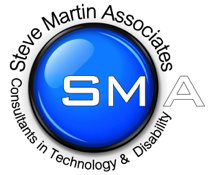Steve Martin Associates
THE HISTORY OF SMA
Steve Martin Associates grew out of one man’s curiosity, determination and belief that technology could open doors for people with disabilities and provide them with opportunities to lead fulfilling lives, with higher levels of independence and maximising educational and personal potential.
EARLY BEGINNINGS
Steve Martin moved from Staffordshire to Gloucester in the late 1970s when he realised that his young son, born with cerebral palsy, needed more than the local schools could offer him. Daniel was enrolled at Chamwells, a school for children with physical disabilities.
Steve, a pharmaceuticals salesman at the time, soon became involved with helping to raise funds for the school. One of the first projects was to raise money for the Possum typewriters the pupils needed. The Possum was essentially an adapted electric typewriter which allowed the keys to be automatically depressed when the user made a choice from a light board on which a keyboard layout was displayed; the user could select a keystroke by pressing a switch when the desired character was illuminated. Costing around £2600 each, the machines were expensive and slow to use but allowed the children to write and communicate to a limited degree despite their disabilities.
Steve began to think that something better than the Possum must be possible – it had a major disadvantage in that it didn’t allow the pupils to read what they had typed and there was no facility to edit and correct mistakes. Knowing nothing about computers, he nevertheless bought one with the intention of adapting it; with the help of a friend, John Taylor, who wrote the software, he produced a prototype which would address the shortcomings of the Possum and was a fraction of the price. Now, using a switch and a technique known as row/column scanning, the user could type, see what they had produced, backspace, edit and correct on a computer screen; furthermore, it provided a word-bank – a precursor to today’s predictive-text facility – which increased writing productivity and meant the computer could also be used as a communication aid, where speed is an important factor.
Word of the new system spread and Steve was approached by a speech and language therapist at the Gloucester Royal Hospital about a severely disabled patient with no apparent communication ability. Within half an hour of using the Elfin system, as it became known, the patient was able to communicate and it was shown that he had retained full cognitive ability.
Steve’s thoughts turned to using this system not just as a word processor but also as a means of environmental control; with John writing the software, he developed an interface which enabled remote control of televisions, video recorders, lights etc.
By late 1983, Steve had given up his job in the pharmaceutical industry ...
The Story of
